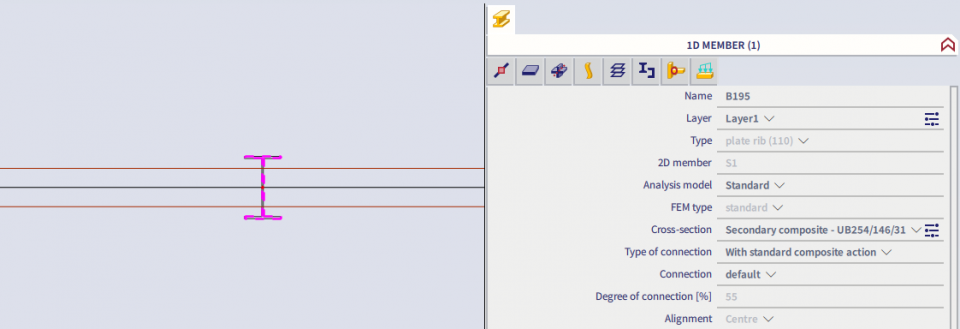Difference between standard and advanced composite action
This FAQ will explain the differences between standard composite action and advanced composite action when working with a composite model in SCIA Engineer.
Standard composite action
This is the conventional approach for modelling composite beams: using a transformed composite cross-section. It produces results that are close to hand calculations. When intending to design composite beams following Eurocode 4 (EN 1994-1-1) based checks, it is recommended to use the property with standard composite action. The composite beam is modelled as a 1D plate-rib member with no eccentricity (alignment = Centre). The calculation will adjust the stiffness of the beam to take into account the eccentricity and the flange width of the composite deck. When using standard composite action, no ‘unexpected’ axial forces appear in the composite beam results.
Analysis model of a composite beam with standard composite action:

Please note, the real eccentricity of the composite beam will not be shown. To correctly visualise the real eccentricity, the structural model should be used. See also following FAQ: Visualise composite beams
Advanced composite action
In this case, the composite beam is modelled as a plate-rib with the real eccentricity (alignment = Bottom), i.e. the steel beam below the composite deck. This case does not use a transformed composite cross-section. Instead, the components (the steel beam and composite deck) forming the composite system are modelled separately. Consequently, this leads to internal forces that are not directly comparable to typical hand calculation methods. For example, in the steel beam component of the composite beam, significant axial forces will appear, and the bending moments will be lower than expected. It is unsafe to use these results when designing to Eurocode 4 because the design code checks do not take axial forces into account.
Furthermore, only full composite action is possible, and therefore it is not suitable for strength (ULS) design where partial composite action is assumed. However, it can be interesting for other design cases such as detailed vibration analysis.
Analysis model of a composite beam with advanced composite action:
